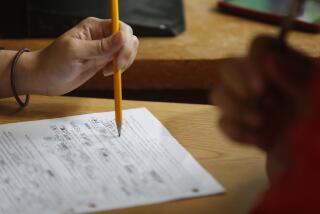Blanking Out on Tests? Use Your Nose
- Share via
What if John Q. Student studies and studies, but still is flunking? The manufacturer of a product called Study Styx says the answer is to . . . inhale.
The $9.95 “stick” is a marker-like tube filled with the scent of lavender, fennel or eucalyptus. The scent is so concentrated that, to some, it’s nauseating. Alicejane Lippner, the New Jersey doctor whose firm makes the product--”Doctor developed!” the label boasts, “Based on scientific research!”--says students score higher on tests if they sniff it first while studying and then again during the exam. The theory: The scent will revive memories of the material the student was reviewing when he or she first smelled it.
Rachel Herz, an experimental psychologist at the University of Pennsylvania who has studied the impact of aromas on performance, doesn’t dismiss the concept. In fact, researchers have found that, under certain circumstances, aromas can boost test scores by 15% or more. But she offers a couple of caveats.
First, the odors have to be unfamiliar--so that smelling them again triggers only the appropriate set of memories. And that causes another problem. Says Herz: “The smell you use for your geography exam should not be used in your chemistry exam.”
Software Offers Framework for Evaluating Students
Educators make no secret of their deep skepticism about standardized testing. But parents--especially many affluent, overachiever types--don’t tend to share those doubts.
They want to know, as precisely as possible, if their kids are keeping up or falling behind.
That’s one reason why Virtual Knowledge, a Massachusetts software firm, has the fastest rate of growth among the 25 largest publishers of educational software, according to PC Data of Reston, Va. The company’s series of computerized vocabulary, math and reading tests--all of which masquerade as games--has sold more than 200,000 copies in less than a year.
The tests tell parents how their kids rank in spelling, say, when measured against their peers.
But Al Noyes, the company’s marketing chief, says parents should use the $29.95 tests with caution. “The best use,” he says, “is for setting priorities for what they can work on with their children . . . and as a framework for a discussion with their teacher.”
Next month, the company will put out a test aimed at preschoolers to see if they can recognize colors, numbers or letters, even if they’re still sitting on their parent’s knee.
Some experts in child development contend that testing of kids younger than second or third grade is misguided. Kids develop at different rates. Besides, the results of such tests can vary wildly from day to day.
On the plus side, Noyes argues, the animated characters, goofy voices and bouncy music of the computerized exams “give a child a very positive introduction to testing, and testing is a fact of life.”
More to Read
Sign up for Essential California
The most important California stories and recommendations in your inbox every morning.
You may occasionally receive promotional content from the Los Angeles Times.













